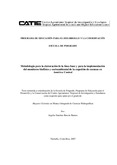Methodology for the base line elaboration and for the implementation of biophysical and socio-environmental monitoring of watersheds co-management in Central America
Alternative title
Metodología para la elaboración de la línea base y para la implementación del monitoreo biofísico y socioambiental de la cogestión de cuencas en América Central
Description
5 ilus. 18 tab. Bib. p. 258-262
Abstract
El objetivo del estudio fue desarrollar una metodología para la elaboración de la línea base y el monitoreo biofísico y socioambiental de la cogestión de cuencas con la participación de actores locales. Primeramente se realizaron reuniones con diferentes actores para abordar la importancia de establecer una línea base y un monitoreo posterior. Después, en un taller con todos los actores interesados se identificaron y seleccionaron un total de nueve indicadores. Posteriormente se tuvo un acercamiento directo con los actores responsables, para realizar una caracterización específica de los indicadores y formatos para recopilar información con sus respectivos instructivos. Se hizo un análisis de la información recabada para valorar su calidad y utilidad y se llevó a cabo la validación en campo. La metodología obtenida resultó posible de implementar por los actores locales, permitiéndoles generar la línea base y el sistema de monitoreo, lo que evita que dicho proceso sea definido de forma externa. Asimismo, se pudieron visualizar las condiciones físicas y biológicas de la cuenca, los roles de los actores, la institucionalidad y los instrumentos de gestión disponibles. De esta manera, los actores locales pueden implementar alternativas que permitan viabilizar las propuestas y acciones de la cogestión de cuencas. The objective of this study was to develop a methodology for the base line elaboration and the implementation of a biophysical and socio-environmental monitoring of watersheds co-management with the participation of local actors. Firstly, meetings were held with different local actors to approach the importanche of establishing a base line and a later monitoring. After that, a total of nine indicators were identified and selected during a workshop. Later, there was an opportune direct approach with the responsible actors to carry out a specific characterization of the indicators and formats to gather information with their respective handbooks. The collected information was analyzed to value its quality and utility. Finally, the validation was implemented in the field. The obtained methodology was successfully implemented by the local actors allowing them to generate the base line and the monitoring system. This positive implementation avoided the process to be defined externally. As a result, the physical and biological conditions of the watershed, the roles of the actors, the institutionally and the available management instruments could be visualizaed In this way, the local actors can implement viable alternatives facilitating watersheds co-management in terMON of proposals and action
Keywords
Publisher
CATIE, Turrialba (Costa Rica)
URI (Permanet link to cite or share this item)
https://repositorio.catie.ac.cr/handle/11554/5321http://orton.catie.ac.cr/repdoc/A1571e/A1571e.pdf
Collections
- Tesis [2996]


